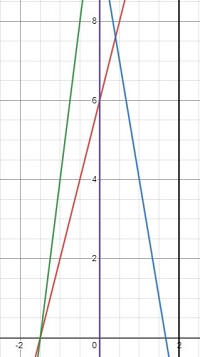
 Data Structure
Data Structure Networking
Networking RDBMS
RDBMS Operating System
Operating System Java
Java MS Excel
MS Excel iOS
iOS HTML
HTML CSS
CSS Android
Android Python
Python C Programming
C Programming C++
C++ C#
C# MongoDB
MongoDB MySQL
MySQL Javascript
Javascript PHP
PHP
- Selected Reading
- UPSC IAS Exams Notes
- Developer's Best Practices
- Questions and Answers
- Effective Resume Writing
- HR Interview Questions
- Computer Glossary
- Who is Who
Program to find how many lines intersect in Python
Suppose we are given a list that contains values in pairs of (m, c). These values represent a line, where y = mx + c. We are also given two values, l, and r. We have to find out the number of the lines that intersect with each other between the range x = l to x = h.
So, if the input is like input_list = [[4, 6],[-6, 10],[8, 12]], l = 0, h = 2, then the output will be 2.

If we look at the given photo, the lines 4x + 6 = 0 and -6x + 10 intersect within the given range. So, there are two lines that are intersecting, so the output is 2.
To solve this, we will follow these steps −
- seg := a list containing pairs [(m * l + c, m * h + c, i) for index i, and values (m, c) in input_list]
- sort the list seg
- ans := a new list of the size of input_list containing 0s
- c := a new map from seg
- for each (x, y, i) in seg, do
- if c[x] > 1, then
- ans[i] := 1
- if c[x] > 1, then
- max_c := -(10 ^ 10)
- prv := -(10 ^ 10)
- for each (x, y, i) in seg, do
- if x is same as prv, then
- ans[i] := 1
- if y <= max_c, then
- ans[i] := 1
- max_c := maximum of (max_c, y)
- prv := x
- if x is same as prv, then
- min_c = 10 ^ 10
- prv = 10 ^ 10
- for each (x, y, i) in seg reversed, do
- if x is same as prv, then
- ans[i] := 1
- if y >= min_c, then
- ans[i] := 1
- min_c := minimum of (min_c, y)
- prv := x
- if x is same as prv, then
- return sum of the elements of list (ans)
Example
Let us see the following implementation to get better understanding −
from collections import Counter def solve(input_list, l, h): seg = [(m * l + c, m * h + c, i) for i, (m, c) in enumerate(input_list)] seg.sort() ans = [0 for _ in input_list] c = Counter(seg) for (x, y, i) in seg: if c[x] > 1: ans[i] = 1 max_c = -(10 ** 10) prv = -(10 ** 10) for (x, y, i) in seg: if x == prv: ans[i] = 1 if y <= max_c: ans[i] = 1 max_c = max(max_c, y) prv = x min_c = 10 ** 10 prv = 10 ** 10 for (x, y, i) in seg[::-1]: if x == prv: ans[i] = 1 if y >= min_c: ans[i] = 1 min_c = min(min_c, y) prv = x return sum(ans) print(solve([[4, 6],[-6, 10],[8, 12]], 0, 2))
Input
[[4, 6],[-6, 10],[8, 12]], 0, 2
Output
2

Advertisements
